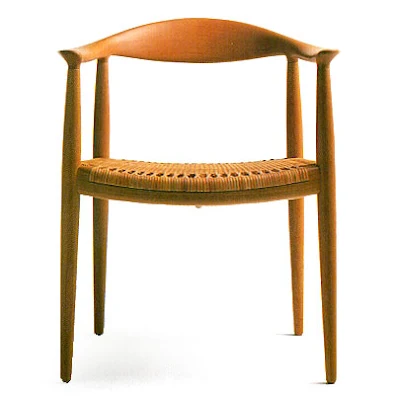Hans Jørgen Wegner, (April 2, 1914 - January 26, 2007), was a successful Danish furniture designer who contributed to the international popularity of mid-century Danish design. His work belongs to a modernist school with emphasis on functionality. He is probably best known for his chairs.
Born to cobbler Peter M. Wegner in Tønder, in southern Denmark,[1] he worked as a child apprentice to Master cabinetmaker H. F. Stahlberg. He soon discovered he had a feeling for wood as a material and developed an affinity towards the material. The cabinetmakers workshop made all sorts of works in wood, and the young Hans Jørgen Wegner soon got an opportunity to experiment with design. Finishing his apprentiship at 17 he remained in the workshop for another three years before joining the army. After serving in the military he went to technical college and then to the Danish School of Arts and Crafts and the Architectural Academy in Copenhagen.
In Copenhagen he became acquainted with the city's Carpenters' Guild Furniture Exhibits, started in 1927 and having become a laboratory for cooperation between Master Cabinetmakers such as Johannes Hansen, L. Pontoppidan, Niels Vodder, Jacob Kjær, A. J. Iversen, Moos and Rudolf Rasmussen; and the best architects of the time, such as Kaare Klint, Vilhelm Lauritzen, Ole Wanscher and Mogens Voltelen.
These annual exhibits gave the young cabinetmaker Wegner a first-hand experience of what the combination of workmanship and design could produce. As a student at the Technical College, Wegner was sometimes sent to the Museum of Art & Design to measure furniture. This gave him another introduction into the world of furniture design. Wegner decided to become a designer. His aim was to produce and sell his furniture and therefore, in 1936, he began studies at what is now The Danish Design School, with O. Mølgaard Nielsen as teacher.
Even his earliest objects, like an armchair with sloping armrests like relaxed wrists (a 1937 design for an exhibit at the Museum of Decorative Arts), exhibited Wegner's approach of "stripping the old chairs of their outer style and letting them appear in their pure construction."
After two years Wegner was employed in Århus, first at architects Erik Møller and Flemming Lassen and then in 1940 at the studio architects Arne Jacobsen and Erik Møller had established together to design and build Århus City Hall. Wegner's task was to design the furniture for the City Hall.
Wegner worked for some time for Arne Jacobsen, a successful Danish designer. Wegner was in charge of the furniture in the Aarhus Municipal Hall, which Jacobsen designed.[1] After some years under Jacobsen, Wegner started his own company. Along with fellow architect Børge Mogensen, he designed furniture for FDB (a Danish chain of grocery stores), spearheaded by Erik Kold - who founded an organization of Danish furniture makers that launched Danish design abroad.
In his later years Wegner became more attached to PP Møbler (which produces most of his designs today) for whom many of his later designs were made. He remained active throughout his life. An example of his later work is the "Hoop Chair", originally designed in 1965 with a steel tube base and finally put into production made entirely in wood in 1985 (for PP Møbler). Wegner has designed furniture for PP Møbler, Johannes Hansen, Carl Hansen & Son, Fritz Hansen, Getama, Fredericia Stolefabrik and others. He designed over 500 chairs and retired from public life only in the last decade of his life.
Wegner received several major design prizes, from the Lunning prize in 1951 and the Grand Prix of the Milan Triennale in the same year, to the Prince Eugen medal in Sweden and the Danish Eckersberg medal. In 1959, he was made honorary Royal designer for industry by the Royal Society of Arts in London.[2] His furniture is present in multiple international collection including the Museum of Modern Art in N.Y. ant the Die Neue Samlung in Munich.
Wegner's chair designs were manufactured primarily by PP Møbler and Carl Hansen & Søn, and were largely free-standing. The "Peacock" chair from 1947, with a slatted back rest fanning out to evoke the bird's plume, was inspired by the traditional "Windsor" chair. His 1949 folding chair was made to be hung on the wall, and his "Shell" chair from the same year experimented with curving the wood in three dimensions to form the seat. The multi-purpose "Valet" chair, designed in 1953, had elements for hanging up or storing each piece of a man's suit. The backrest is carved to be used as a coat hanger, pants can be hung on a rail at the edge of the seat and everything else can be stowed in a storage space underneath the seat. In 1960 he came out with several variations on the "Ox" chair which came with or without horns, and showed the less serious side of Wegner's designs. "We must take care," he once said, "that everything doesn't get so dreadfully serious. We must play--but we must play seriously." In more recent years he has continued to design chairs and has also worked with lighting, such as the "Pole" lamp created in 1976 with his daughter Marianne. Wegner has stated that, "the chair does not exist. The good chair is a task one is never completely done with."




























No comments:
Post a Comment